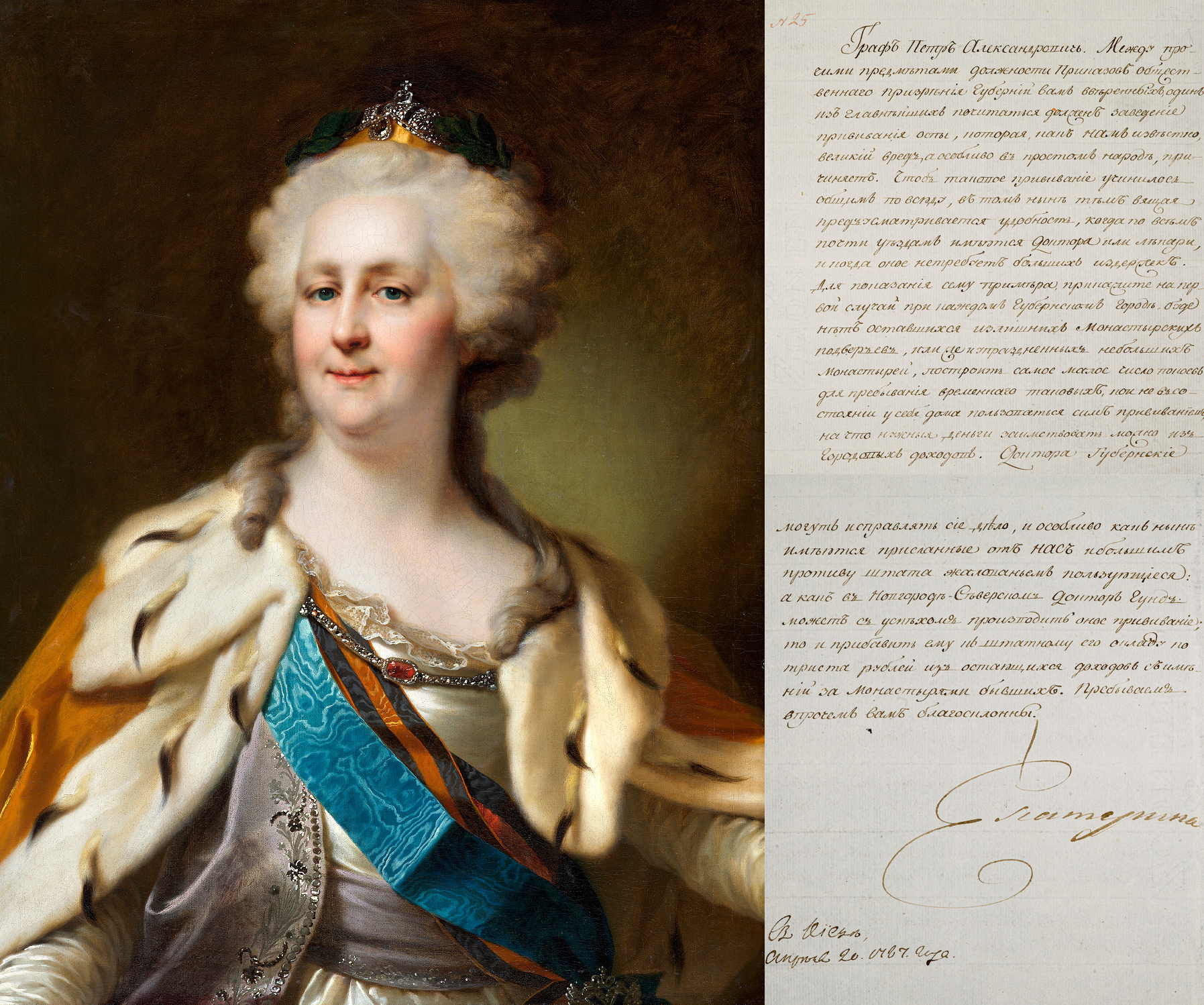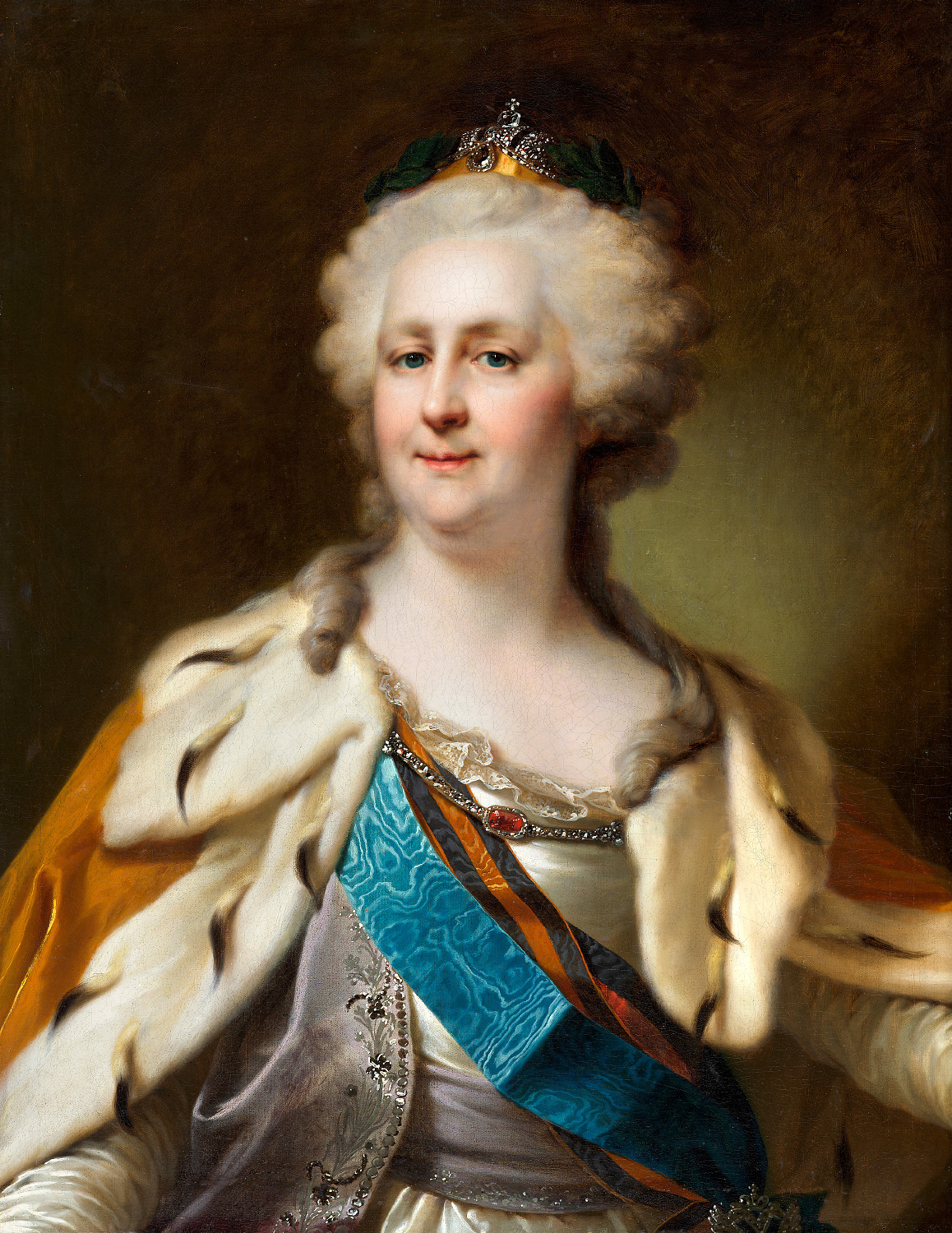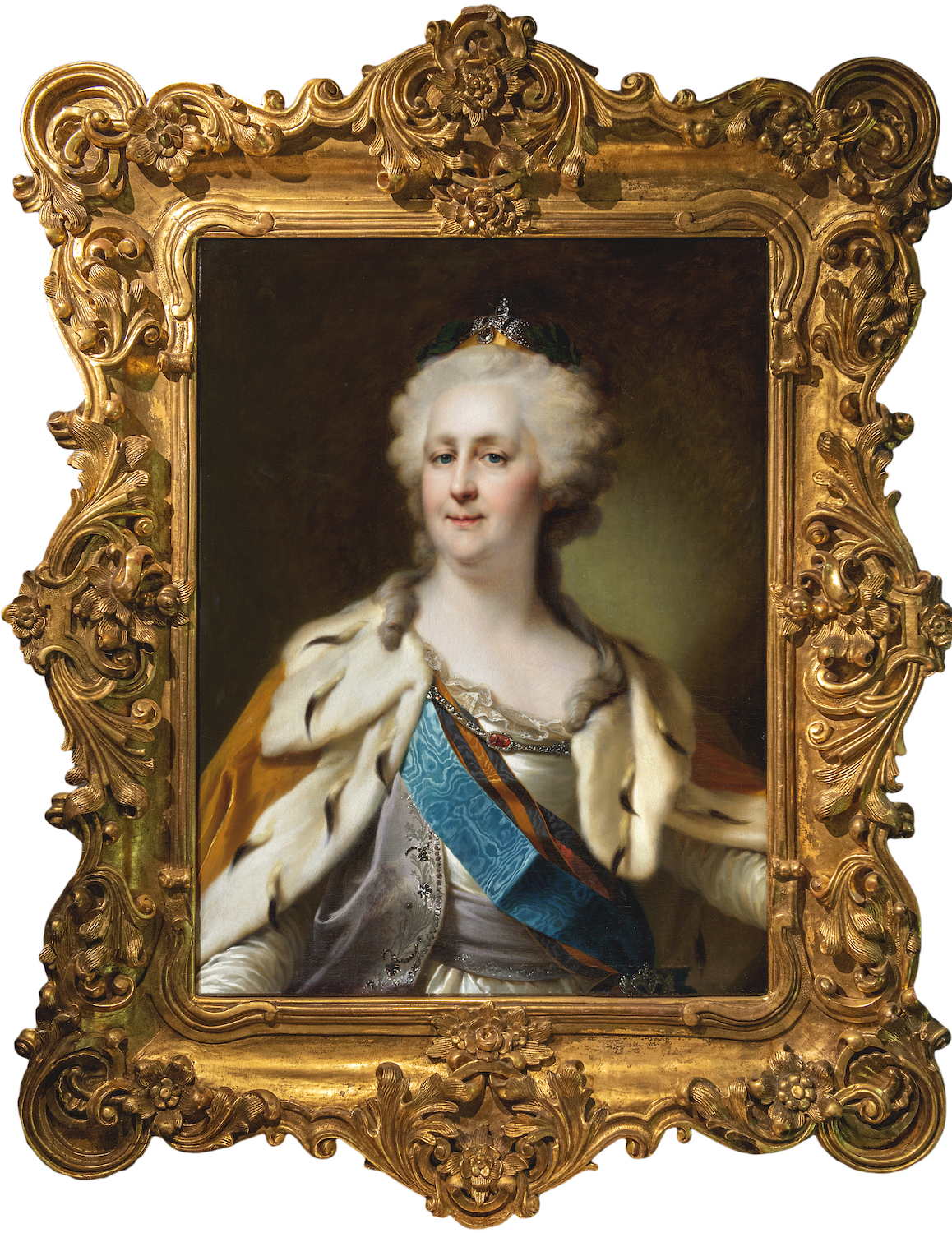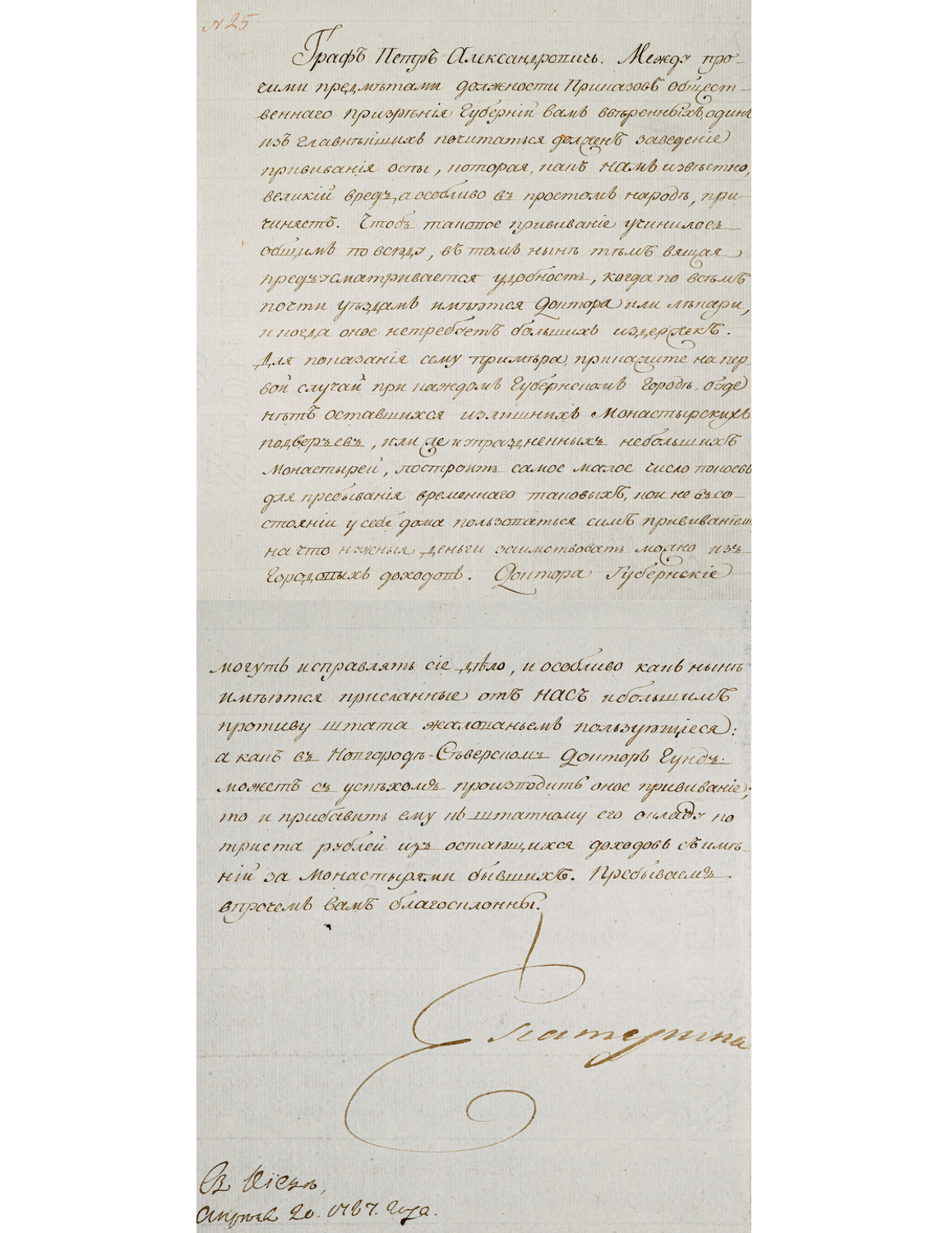Important Russian Art
1 December 2021

◎ 14. Portrait of the Empress Catherine the Great by Dmitry Levitsky, with Letter from Catherine the Great to Count Piotr Aleksandrovich Rumiantsev on Vaccination Against Smallpox, 20 April 1787
PROPERTY FROM A DISTINGUISHED PRIVATE COLLECTION, RUSSIA
SOLD FOR 951,000 GBP
LEVITSKY, DMITRY (1735–1822)
Portrait of the Empress Catherine the Great.
Oil on canvas, 81.5 by 64 cm.
Provenance: Important private collection, Russia.
Authenticity of the work has been confirmed by the experts G. Goldovsky and S. Moiseeva.
Exhibited: Sokrovischa chastnoi kollektsii v Tsarskom Sele, Tsarskoe Selo State Museum and Heritage Site, St Petersburg, 6 June–23 September 2012.
Vzgliad iz proshlogo, Tsarskoe Selo State Museum and Heritage Site, St Petersburg, 22 January–21 March 2016.
Zhivopisnyi portret XVIII–XIX vekov, The State A. S. Pushkin Museum, Moscow, 2 June–2 October 2016.
Russkii portret, Pavlovsk State Museum-Reserve, St Petersburg, 27 July–15 October 2016.
Georg Khristof Groot i Elizavetinskoe vremia, State Russian Museum, St Petersburg, 2 December 2016–13 March 2017
Istoriia v litsakh. Shedevry portretnoi zhivopisi XVIII–XIX vekov, Art Centre. Moscow, 20 May–20 September 2017.
Vystavka odnogo shedevra, Peterhof State Museum-Reserve, St Petersburg, 10 June–3 September 2018.
Pisma i litsa Imperii. Portrety i pisma rossiiskikh imperatorov. Ot Petra I do Aleksandra II, Art Centre. Moscow, 15 October 2020–15 November 2021.
Literature: Exhibition catalogue, Sokrovischa chastnoi kollektsii v Tsarskom Sele, St Petersburg, Tsarskoe Selo State Museum and Heritage Site, 2012.
Exhibition catalogue, Vzgliad iz proshlogo, St Petersburg, Tsarskoe Selo State Museum and Heritage Site, 2016, pp. 53–55.
MacDougall’s presents the stately painting of Catherine II, executed by the celebrated portrait artist Dmitry Levitsky, whose depictions of the Empress and members of the Russian aristocracy feature among the treasures of the 18th-century Russian art.
In particular, among the famous, established images of the monarch is a portrait of Catherine as the “Lawgiver in the Temple of Justice”, replete with numerous symbols and allegories, that Levitsky painted and often repeated. Several versions are known to exist, and they are exhibited in the major museums throughout Russia.
Overall, Levitsky created some twenty images of the Empress, but there is no evidence to suggest that Catherine ever posed personally for him. In keeping with a practice that was widespread at the time, the painter used the “warranted at the highest level” templates when working on his compositions. That is why, in the earlier portraits of Catherine the Lawgiver, reposited in the Russian Museum and the Novosibirsk Art Museum (ill. 1 and 2), the monarch’s image harks back to the so-called iconographic type produced by Fedor Rokotov in the late 1770s. In the later ones, from the Tretyakov Gallery and the Novgorod Museum-Reserve (ill. 3 and 4), however, a different source is brought into play – the iconographic type executed by Johann Baptist Lampi the Elder.
There is no doubt that the image of the Russian monarch now presented for auction is an example of this Lampi-style portrayal. At Catherine’s invitation, Lampi the Elder arrived in Russia with his son and assistant in 1792. The famous Austrian artist’s very first work in St Petersburg was a full-length portrait of the Empress, painted from life. It was executed in two versions – one with allegorical figures representing Firmness and Verity (Hermitage Museum, ill. 5) and the other with the figures of Saturn and History (Russian Museum). On both canvases, the autocrat was depicted wearing a small crown with a laurel wreath and the ribbons of the most important Russian decorations – the Orders of Saint Andrew the First-Called, Saint Vladimir 1st class and Saint George 1st class. Catherine liked the portraits, and the painter received a monetary reward and an annual allowance accordingly. The canvases were also praised by his contemporaries. In particular, Gavriil Derzhavin commended them in verse: “Your mastery, O Lampi, / In a woman has here revealed itself to the universe / Mind, great spirit and divine nature – in the image of Catherine embodied”.
Catherine the Great is depicted, in the ceremonial half-length portrait to be auctioned, wearing the same Order ribbons, a small crown and an ermine-lined mantle. However, Levitsky does not merely copy the template offered to him, but he gives it an original, creative reinterpretation. The Empress as portrayed by Levitsky looks more youthful than in Lampi’s canvases. The modelling of the face has also been slightly altered and its oval shape softened, the figurative treatment as a whole looks less formal, and the monarch’s lips have taken on a restrained half-smile. Levitsky has managed to strikingly represent the real person and to embellish the image without detracting from the outward resemblance. This is the way in which Catherine was shown on the famous “katerinka”, 100-ruble banknote, issued in 1910 (ill. 6).
This portrait, then, executed by one of Russia’s greatest 18th-century masters, may rightly be regarded as a highest quality work by Dmitry Levitsky in its own right. It is one of the examples of Catherine the Great iconography, which are extremely rare on the art market.
LETTER FROM CATHERINE THE GREAT TO COUNT PIOTR ALEKSANDROVICH RUMIANTSEV ON VACCINATION AGAINST SMALLPOX DATED 20 APRIL 1787.
Signed "Iekaterina", inscribed "V Kiev" and dated "Aprelia 20. 1787. goda".
Ink on paper.
“Count Piotr Aleksandrovich, among the other duties of the Welfare Boards in the Provinces entrusted to you, one of the most important should be the introduction of inoculation against smallpox, which, as we know, causes great harm, especially among the ordinary people. Such inoculation should be common everywhere, and it is now all the more convenient, since there are doctors or medical attendants in nearly all districts, and it does not call for huge expenditure.
“To set an example of this, issue an order on the first occasion in each provincial town, to count the remaining superfluous conventual residences or the small monasteries that have been abolished, and build the minimum number of lodgings for the temporary stay of those who are unable to have this inoculation at home; money needed for this could be borrowed from town revenues. Provincial doctors can put this matter right, especially since now there are people sent from us who have a low salary against the regulations: so, since Dr Gund in Novgorod-Seversky can successfully carry out this inoculation, then add three hundred rubles to his regular salary from the remaining income from the former monastery estates. We remain, by the way, favourably disposed towards you. CATHERINE
To Kiev,
April 20. year 1787."
Catherine the Great’s letter to Count Petr Alexandrovich Rumiantsev, offered for auction, about inoculating against smallpox in parts of present-day Ukraine, bearing the Empress’s personal signature, is not only a unique, authentic document from that age, but also an extremely pertinent testimony to the statecraft and foresight shown by the great monarch.
The letter is dated 20 April 1787 and contains an instruction to the governor-general and vice-regent of Malorossiya to treat smallpox inoculation in the province entrusted to him as one of the main “duties” of his position, so that “such inoculation should be common everywhere”. By this time, the Empress herself and the heir to the throne, Pavel Petrovich, had been vaccinated for almost twenty years, but the task of inoculating the population of the Empire remained extremely acute and was meeting with resistance on the ground. Smallpox epidemics were still appallingly severe in Europe in the 18th century and often claimed the lives of entire villages. Scars from earlier encounters with the disease covered the bodies and faces of most people in all social classes.
On the day before his wedding, Catherine’s future husband, Grand Duke Piotr Fedorovich, fell victim to an epidemic, and he was permanently disfigured by the pockmarks. The habit of fearing smallpox was “in the blood” of a person living at that time, and Catherine confessed in a letter to the Prussian king, Frederick the Great: “Ever since my childhood, I was inured to the horror of smallpox, and at a more mature age it took a great deal of effort to alleviate that horror ... Last spring, when the disease was rampant here, I used to run from house to house ... not wanting to endanger my son or myself. I was so struck by the vileness of such a situation that I considered it a weakness not to avoid it. I was advised to inoculate my son with smallpox. I used to reply that it would be shameful not to start with myself, and how could I introduce smallpox vaccination without setting a personal example? I began to study the subject ... Should I remain in real danger, together with thousands of people, throughout my life, or should I prefer a lesser danger, a very brief one, and so save many people? I thought that by choosing the latter, I was selecting the best course ...”.
So the enlightened Empress was the first person in Russia to have herself vaccinated against smallpox, and then the heir to the throne in the autumn of 1768. The smallpox vaccination method was then quite dangerous. Essentially, it consisted of threads or a piece of fabric moistened with the contents of a sick person’s smallpox pustules being pulled through a healthy person through subcutaneous incisions in the arm. The infection would enter the bloodstream, and the person became infected. Mortality after inoculation by the “variolation” method was 2%, that is 20 times less than usual. But the risk remained, and there were many opponents of vaccination.
The historian Sergei Soloviev wrote: “Doctors howled against the insane novelty, preachers howled at it from church pulpits ... Catherine decided to put an end to the Russian public’s hesitation by her own example.” An English doctor, Thomas Dimsdale, was invited to St Petersburg, since his track record included enough precedents of him successfully inoculating the British Royal family and the aristocracy against smallpox. Nevertheless, just in case the procedure failed, and she died, Catherine prudently provided the doctor with protection against any reprisals by her subjects, and she ordered that a mail carriage should be kept ready for him, as he might need to leave the country in a hurry. The convalescent six-year-old Alexander Markov, son of a Sergeant-Major, was the donor of infected lymph for the monarch. Everything turned out well, though, and, after a week of mild discomfort, the Empress’s recovery was triumphantly announced on 29 October 1768. The Synod and the Senate sent greetings to Catherine, and 21 November 1768 was declared a day of celebration in Russia to honour Her Imperial Majesty’s “magnanimous, unparalleled and illustrious deed”. Dimsdale was awarded the title of baron, an annual pension of £500, the title of physician-in-ordinary to the sovereign, and a portrait of the Empress as a gift.
After the successful experiment, Catherine proudly wrote to her ambassador plenipotentiary in Britain, Count Ivan Grigorievuch Chernyshev: “We now have only two topics of conversation: the first is the (Russo-Turkish) war, and the second is vaccination. Starting with me and my son, who is also recovering, there is no noble house in which there are not several vaccinated persons, and many regret that they had smallpox naturally and so cannot be fashionable. Count Grigory Grigorievich Orlov, Count Kirill Grigorievich Razumovsky and countless others have passed through Mr Dimsdale’s hands – and even renowned beauties... Here is what example means”. An allegorical ballet, Prejudice Defeated, was staged at the court theatre, while, for the common people, a start was made on producing pictures in popular prints that promoted vaccination.
Dimsdale’s scientific work, The Present Method of Inoculating for the Small-Pox..., was translated into Russian and published in 1770, and the variolation method itself began to be introduced everywhere nationally. However, the process made little headway, and the Empress’s letter that is presented for auction shows once again that, in 1787, the problem of smallpox vaccination in the outlying parts of the Empire was still acute and called for administrative intervention and supervision.



Notes on symbols:
* Indicates 5% Import Duty Charge applies.
◎ Indicates the lot is located in Russia. Please note that permit for export from Russia has not been obtained. Successful bidders would collect their lots in Moscow after payment.
Ω Indicates 20% Import Duty Charge applies.
§ Indicates Artist's Resale Right applies.
† Indicates Standard VAT scheme applies, and the rate of 20% VAT will be charged on both hammer price and premium.